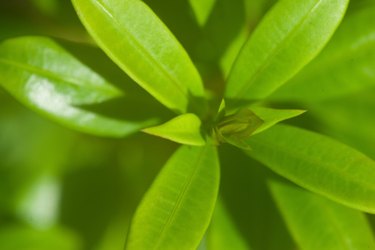
Many popular indoor plant species have waxy leaves. The wax gives the foliage of these plants an attractive, glossy finish, but it is not just for show. The "wax" is in fact a cuticle that allows these plants to retain moisture. Many waxy plant species can therefore go without water for extended periods of time, which is why they make excellent indoor specimens.
Waxy Indoor Plant Species
Video of the Day
Plants in the genus Hoya (Hoya spp.) are literally known as wax plants on account of their small, waxy leaves. The foliage sometimes has white or silver flecks. The vines of the wax plant can be trained on a trellis, or they can be grown in baskets. Wax plants need very small amounts of water, and Hoya plants are among the easiest plants to grow indoors.
Video of the Day
Another waxy leaves plant example is the baby rubber plant (Peperomia obtusifolia), which is native to South America and the West Indies. It is often used as a desktop plant, and there is a cultivar with variegated leaves available. The baby rubber plant, also known as blunt-leaved peperomia, requires high humidity in the hot summer months, so placing it on a tray of wet pebbles is a good idea.
Succulents With Waxy Leaves
Noncactus succulents often have waxy foliage. These desert-dwelling plants store water in their fleshy leaves and make cool houseplants. The wax makes these plants virtually waterproof, which allows them to conserve moisture in arid environments. The wax sometimes appears like a powdery white substance on the leaves.
An example of such a succulent is the kalanchoe, which is native to Madagascar. It has thick, dark green leaves and offers a variety of flower colors, including red, pink and white. Allow the soil of kalanchoe succulents to dry out between waterings, as too much water can damage the plant. Bright light is key to keeping kalanchoe plants healthy.
The jade plant (Crassula ovata), which grows branching stems like a small shrub and can go months without water, is also a waxy-leaved succulent. It can develop hints of red in bright sunlight.
Tropical Waxy Plants
The Swiss cheese plant (Monstera deliciosa), a vining plant that gets its name from the holes that develop in its foliage as it ages, has large, waxy, heart-shaped leaves. There are dark green and variegated varieties of this plant from which to choose. As a tropical plant that is native to Mexico and Central America, the Swiss cheese plant requires 50 to 60 percent humidity.
Another tropical plant with waxy foliage is the umbrella tree (Schefflera actinophylla), also known as the octopus tree, which is native to Australia and New Guinea. While the umbrella tree can be grown outdoors, it is most often used as a houseplant. In Florida, the umbrella tree is considered an invasive species.
Consider also the weeping fig (Ficus benjamina), a broadleaf evergreen plant that hails from Southeast Asia and Australia and has waxy, tear-shaped leaves. You can find weeping figs with braided trunks for indoor spaces.
- Clemson Cooperative Extension: Kalanchoe
- Missouri Botanical Garden: Peperomia obtusifolia
- NC State Extension: Peperomia obtusifolia
- Better Homes & Gardens: 23 of the Easiest Houseplants You Can Grow
- Missouri Botanical Garden: Crassula ovata
- HGTV: How to Care for Monstera, the Swiss Cheese Plant
- Missouri Botanical Garden: Schefflera actinophylla
- Missouri Botanical Garden: Ficus benjamina